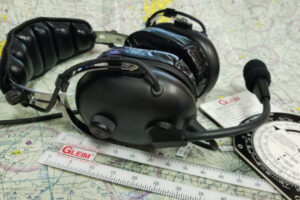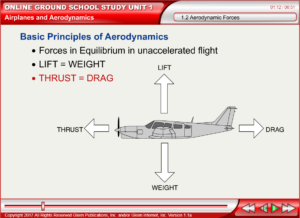 With all the checks we perform and procedures we follow to keep safe, it can be easy to overlook one of the most essential safety tools we have at our disposal – our language! Aviation English is the language used around the world by aviation professionals, on the ground and in the air. Universal use of Aviation English helps to minimize the number of accidents caused by miscommunication.
With all the checks we perform and procedures we follow to keep safe, it can be easy to overlook one of the most essential safety tools we have at our disposal – our language! Aviation English is the language used around the world by aviation professionals, on the ground and in the air. Universal use of Aviation English helps to minimize the number of accidents caused by miscommunication.
Flight Instructors play an essential role in ensuring that all airmen meet the FAA Aviation English Language Standards (AELS). As a flight instructor, you have the unique position of being able to recognize deficiencies and address them before they become a potential hazard.
Common Obstacles to Aviation English Proficiency
It is not uncommon for foreign nationals training to be pilots to experience difficulties communicating with Air Traffic Control (ATC) when they first begin. That’s not to say foreign nationals struggle with speaking English – many are well-equipped to read, write, and speak conversational English; however, some situations that arise in the National Airspace System (NAS) can be stressful, and this stress can make it a difficult struggle to communicate clearly and effectively. Learning a new language is challenging, and it can compound the already-present stress of learning to fly. It is for this reason that many flight schools require students to obtain a Level 4 English Language Certification, an “operational level of proficiency,” prior to enrollment.
Make sure your foreign students can understand common phrases that may not be in the Airman Information Manual (AIM). While “Make a 180,” “Pass abeam or behind,” and “Square your base to final” make sense to people raised in the United States, they aren’t always clear to foreign students. Help students out if you notice them struggling with idiomatic phrases. Your safety, their safety, and the safety of your fellow pilots is paramount.
Native English speakers are not off the hook, though! Aviation English has several idiosyncrasies that must be learned. Also, while native speakers are automatically awarded level 6 ICAO status, they might use non-standard terms, become impatient with non-native speakers, or might simply speak too fast. These shortcomings tend to worsen during emergencies.
Pia McDonald, the Chair of the Aviation English Department at Sunrise Aviation in Ormond Beach, FL, recalled one instance when she realized one of her own students might not be at an operational level of proficiency in Aviation English. The student earned an almost perfect score on a written test, so she wrote the word “outstanding” across the top of the paper. After the class session, the student, confused, wanted to know why they had to “go outside and stand.” McDonald took this as a reminder that students at the pre-operational level tend to interpret everything they hear literally and often have trouble with understanding the context of a word or phrase. To avoid miscommunication it is imperative for instructors to verify the comprehension of the information given by asking follow-up questions since “Did you understand?” might not be enough.
McDonald has a degree in Foreign Language Teaching. She has taught English for a Specific Purpose (ESP) for many years to military and civilian international pilots and has also taught English for Academic Purposes (EAP) and English as a Second Language (ESL) in universities, both in the States and abroad. McDonald said reluctance of students and instructors to accept and promote Aviation English instruction has been a problem. That said, she has seen attitudes change since the FAA updated Advisory Circular 60-28, “FAA English Language Standards” in June 2017. The FAA has been promoting the importance of AELS to the training industry, in part through outreach to flight instructors.
How to Evaluate Student’s Aviation English Language Proficiency
 McDonald asserts that CFIs need to take a more active role in identifying Aviation English deficiencies. “There is no standardized test or one-size-fits-all approach to language assessment. Someone will need to have an actual exchange with the student” she says. As more people come to the United States for flight training, CFIs need to familiarize themselves with the FAA/ICAO language proficiency rating scale as well as the various cultural aspects of learning. Some cultures promote strict memorization of terms and concepts while others promote a more hands-on learning style. Instructors should be able to help students learn in their preferred method, but also need to address any gaps in learning that arise from using those learning styles.
McDonald asserts that CFIs need to take a more active role in identifying Aviation English deficiencies. “There is no standardized test or one-size-fits-all approach to language assessment. Someone will need to have an actual exchange with the student” she says. As more people come to the United States for flight training, CFIs need to familiarize themselves with the FAA/ICAO language proficiency rating scale as well as the various cultural aspects of learning. Some cultures promote strict memorization of terms and concepts while others promote a more hands-on learning style. Instructors should be able to help students learn in their preferred method, but also need to address any gaps in learning that arise from using those learning styles.
McDonald was careful to point out that, sometimes, issues unrelated to culture or language can contribute to students struggling with Aviation English. A student lacking motivation to study will likely experience difficulty recalling proper terminology. A student struggling with learning aviation skills and techniques will also struggle to correctly use the corresponding language. In extreme cases, the anxiety associated with flight training further impacts the student’s ability to communicate effectively.
Evaluating students needs to be a continual process. One of the tools McDonald recommends is the usage of every day aviation materials. “Have your students read, or watch a video, for example about aeromedical factors or a National Transportation Safety Board (NTSB) accident analysis. Then, question them about what they read or watched.” At a minimum, instructors should be looking for the ability to describe an action or video with clarity and ease. If the student does not understand something, do they guess or do they ask for clarification? Conversational questions are asked to evaluate pronunciation, grammar, and vocabulary in addition to the ability to paraphrase successfully. If the instructor is unsure of the student’s operational language proficiency at any point, it is best to refer the student to an Aviation English instructor, though they are far and few in between.
The ability to address student failure to meet AELS is heavily dependent on the resources available. Flight schools can work to shift the culture around Aviation English by hiring more Aviation English instructors, connecting students with remedial classes, and ensuring that the incentives they provide CFIs for advancing students through the program do not run counter to safety. Flight school managers should make an effort to learn what resources would be most beneficial to their schools. Business goals do not always align with instructional goals, but this is one key area where there is plenty of room for them to overlap and for managers to develop solutions. Aviation English expertise is a very marketable specialty.
Flight instructors can familiarize themselves with the ICAO English levels by listening to audio samples and find additional resources for FAA AELS evaluation at the ICAO language proficiency website.
Students requiring remedial training usually study with books; however, most of the books available for Aviation English are written for airline pilots. This can be a real obstacle for students who are starting with their initial training, because the concepts will be unfamiliar.
What Resources are Available for Aviation English Language Training?
As with learning any new language, the best way to improve is to immerse yourself in it. Training should be conducted in English. If a student does not understand a concept, word, or phrase, instructors typically use pictures and models or mimic movement and actions. Translation is a last resort that should be avoided. Comprehension must happen in English, as it is critical to be able to communicate quickly and clearly in emergency scenarios.
Students also need to be familiar with all types of runways and airport layouts. Sometimes, ATC will issue a new approach, and pilots need to be prepared to understand or else risk becoming disoriented. Instructors should arrange for their students to visit a tower facility. Seeing the controllers and what they do with the information provided to them by pilots will reinforce the need to adhere to strict Aviation English standards.
 Gleim Aviation Instructor, Paul Duty, recommends using a combination of resources to help foreign students learn Aviation English. The Gleim Online Ground School courses include audio/video presentations that have all the elements necessary to develop an operational level of proficiency, including audio, descriptive and representative imagery, and on-screen text. This allows foreign students to hear, read, and see the content, which reinforces comprehension. “Using these products is a natural fit for aviation training. Foreign students will see their peers using the same products, which helps reduce student reluctance to participate” said Duty.
Gleim Aviation Instructor, Paul Duty, recommends using a combination of resources to help foreign students learn Aviation English. The Gleim Online Ground School courses include audio/video presentations that have all the elements necessary to develop an operational level of proficiency, including audio, descriptive and representative imagery, and on-screen text. This allows foreign students to hear, read, and see the content, which reinforces comprehension. “Using these products is a natural fit for aviation training. Foreign students will see their peers using the same products, which helps reduce student reluctance to participate” said Duty.
Foreign students can use the Gleim Audio Review for Private Pilot and Audio Review for Instrument Rating to learn the course, while incidentally learning Aviation English through clearly spoken language and detailed explanations. According to McDonald, “the Gleim Audio Lectures are very good as listening comprehension practice tools.”
The FAA Safety Team recently reminded instructors in a December 6th email that “the Aviation English Language Standard is an eligibility requirement for all Airman Certificates. Additional guidance for instructors can be found in Advisory Circular 61-65H.”
Flight Instructors are always going to be the first line of defense when it comes to pilot safety. Instructors are responsible for ensuring their students are trained well enough to ensure safe operations in the NAS. If you need more guidance on evaluating your students, refer to the current version of Advisory Circular 60-28 or speak with an Aviation Training Consultant at Gleim by calling 800-874-5346 ext. 471.
Additional resources:
About Gleim Aviation
Since 1980, Gleim Aviation’s team of pilots, instructors, writers, designers, and programmers has helped aviators pass millions of FAA knowledge and practical tests using the unique Gleim Knowledge Transfer System. Gleim is an environmentally-friendly company headquartered in Gainesville, FL.

